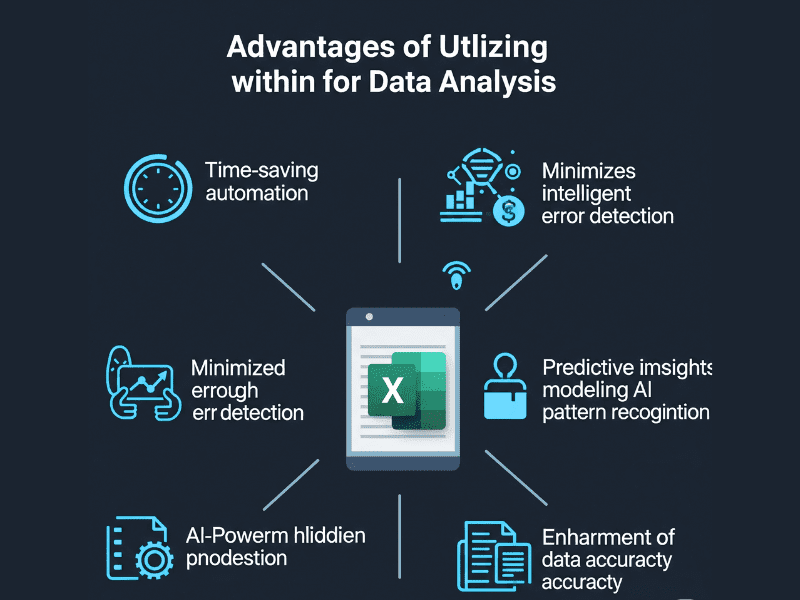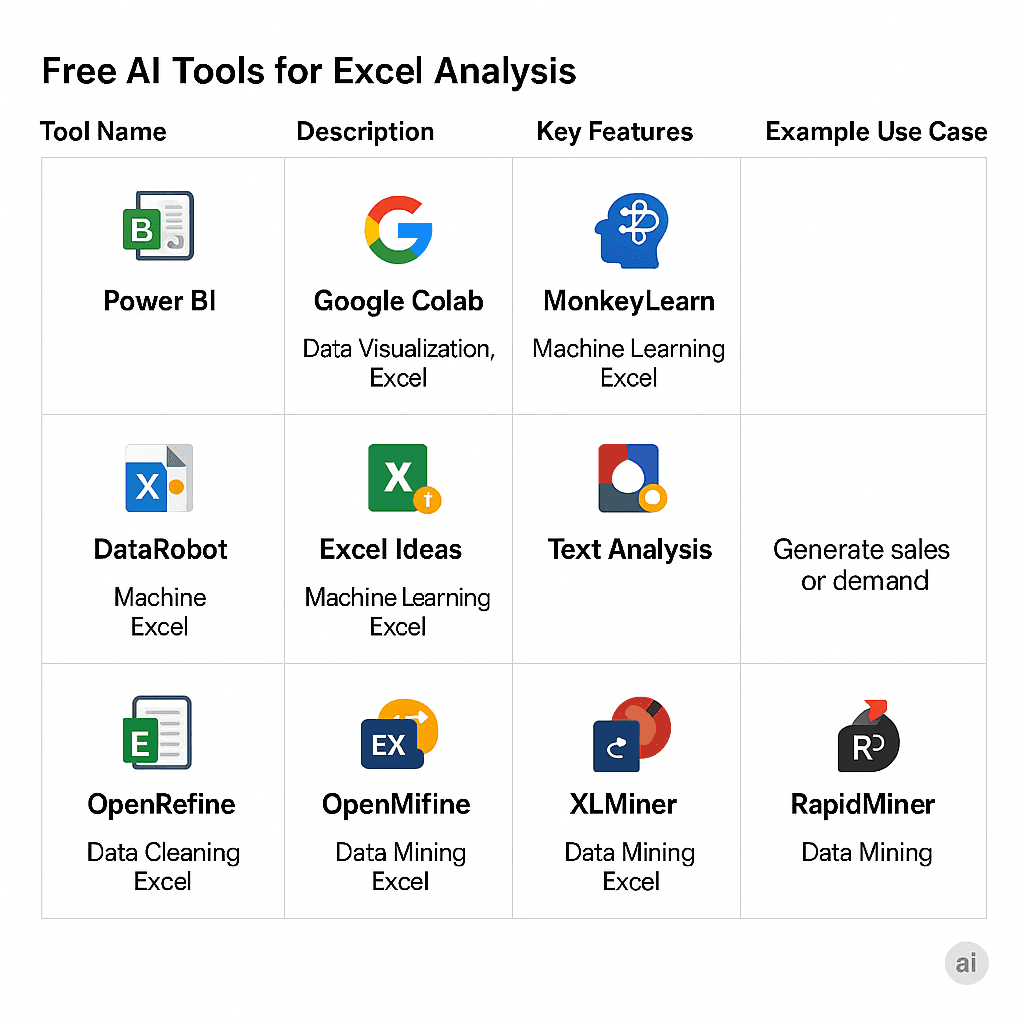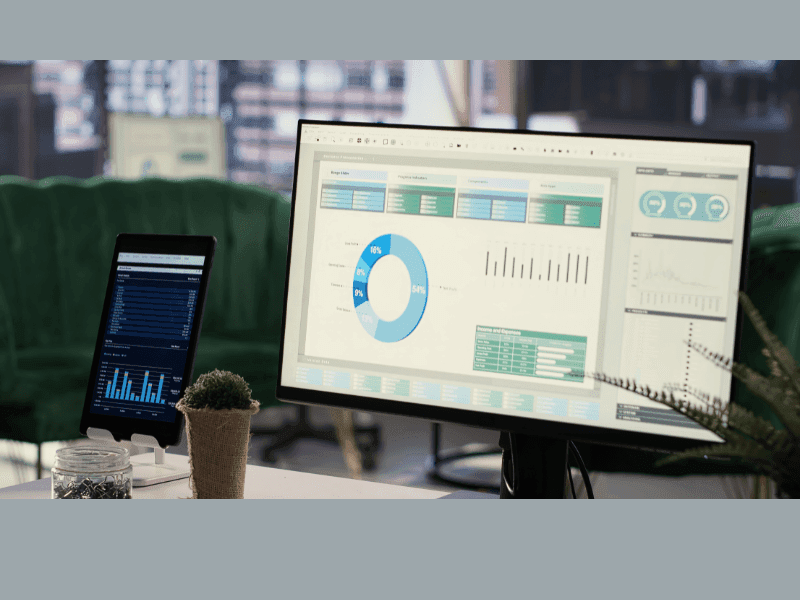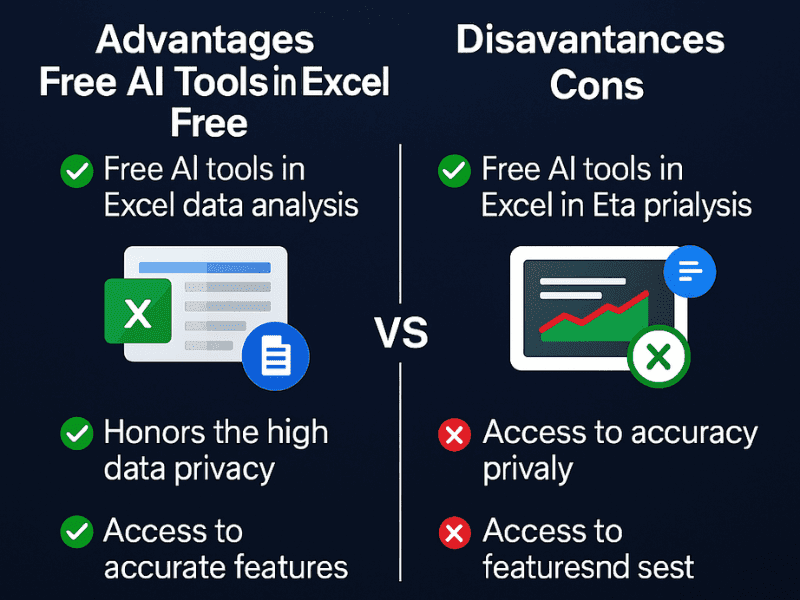Introduction: Why Use Free AI Tools for Excel Data Analysis? 🤔
Quick Navigation
Toggle
Although Excel has long been the preferred tool for data analysis, you can now enhance your spreadsheets without investing a dollar thanks to the rapid advancement of AI technology.
“Free AI tools for Excel data analysis” is the key phrase here, and it’s clear why more professionals and students are using these cutting-edge solutions.
These tools make data-driven decisions quicker and more accurate, automate time-consuming tasks, and reveal hidden insights.
Free AI tools for Excel data analysis can increase your productivity and save you time, regardless of your level of experience as an analyst.
We will examine the top free AI tools for Excel data analysis in this guide, including their features, usage instructions, advantages and disadvantages, and a detailed sample.
Let’s dive in!
🚀 Why Are AI Tools Helpful for Excel Data Analysis?

Simplify Complex Tasks ✨
Repetitive tasks like data cleaning, spreadsheet organization, and report generation can be automated with AI solutions.
Improve Accuracy 🎯
They lessen human error that occurs when calculations or data entry are done by hand.
Discover Hidden Insights 🔍
Patterns and trends that the human eye would overlook are detected by AI algorithms.
Save Time ⏳
You can concentrate on strategic decision-making rather than tedious calculations when you use automated analysis.
Cost-Effective Solutions 💸
Everyone can now access expert data analysis because to the abundance of robust AI technologies that are freely available.
🔍 Top Free AI Tools for Excel Data Analysis (With Features & Use Cases)

Here, we list 7-10 free AI tools that integrate with or complement Excel for data analysis.
Key Features:
- Reports, dashboards, and data visualization
- Questions in natural language
- Modeling and transforming data
- Use Cases:
- Using Excel data to create interactive dashboards
- Effectively analyzing big datasets
How to Use with Excel:
- Export data from Excel or use Power BI to connect straight to your spreadsheet.
- For insights, use the integrated AI visualizations.
Key Features:
- Free Jupyter notebooks on the cloud
- Deep learning and machine learning capabilities
- Using the Pandas library to integrate Excel files is simple.
Use Cases:
- Using Excel data to create predictive models
- Automating clustering and classification of data
How to Use with Excel:
- Use Google Drive to upload your Excel file.
- Use Python libraries to examine it after importing it into Google Colab.
Key Features:
- Sentiment analysis, classification, and text analysis
- An easy-to-use interface for creating personalized models
Use Cases:
- Examining client comments that are kept in Excel
- Automatically classifying survey responses
How to Use with Excel:
- Save your Excel data as a CSV file.
- Train your model by uploading it to MonkeyLearn.
Key Features:
- Machine learning that is automated (AutoML)
- Tools for deploying and interpreting models
Use Cases:
- Using Excel data to forecast sales or demand
- Finding the important elements in your dataset
How to Use with Excel:
- DataRobot can import your Excel data.
- Allow the platform to automatically create and evaluate models.
Key Features:
- AI-driven insights right in Excel
- Patterns, trends, and summaries of data
Use Cases:
- Brief summaries of data to aid in decision-making
- Finding irregularities in your data
How to Use with Excel:
- Choose your data in Excel.
- To create insights, click the “Ideas” button.
Key Features:
- Data transformation and cleaning
- Plugins for integrating AI and machine learning
Use Cases:
- Organizing disorganized Excel datasets
- Data preparation for additional AI analysis
How to Use with Excel:
- Excel data can be exported as CSV.
- OpenRefine imports and uses AI plugins.
7. Excel Add-ins: DataRobot, XLMiner, and More 🛠️
Key Features:
- Functions of embedded AI and machine learning
- Predicting, classifying, and grouping data
Use Cases:
- Creating forecasting models straight in Excel
- Using sophisticated statistical analysis
How to Use with Excel:
- Install and download the Office Store’s free add-ins.
- Utilize their user interfaces to examine your information.
Key Features:
- Data analysis visual workflow designer
- Integrated algorithms for machine learning and AI
Use Cases:
- Using Excel data for data mining and predictive analytics
How to Use with Excel:
- Excel data can be exported as CSV.
- Open RapidMiner, import, and establish workflows.
📊 Step-by-Step Example: Using Microsoft Power BI for Excel Data Analysis

Let’s walk through a simple example of how to leverage free AI tools for Excel data analysis with Power BI.
Step 1: Prepare Your Excel Data 📂
Make sure your data is clean and organized in Excel.
Step 2: Import Data into Power BI 🖥️
Open Power BI Desktop, click “Get Data,” and select your Excel file.
Step 3: Create Visualizations 📈
Use Power BI’s AI visuals like “Decomposition Tree” or “Key Influencers” to analyze your data.
Step 4: Explore Insights 🔍
Interact with your dashboards to uncover trends or anomalies.
Step 5: Share Your Findings 📤
Publish your report to Power BI service or export it for sharing.
This example shows how free AI tools for Excel data analysis can turn simple spreadsheets into insightful dashboards effortlessly.
✅ Pros and Cons of Free AI Tools for Excel Data Analysis

Pros:
- Economical (free) 💰
- Interfaces that are easy to use 🧑💻
- Automate time-consuming chores ⏱️
- Make better decisions 📊
Cons:
- fewer sophisticated features than those of the premium versions ♠️
- Basic coding knowledge is required for certain tools (like Python and R) 🔧
- Cloud-based tools and data privacy issues ☁️
🏆 Final Recommendations
Because of its robust capabilities and ease of use, we suggest Microsoft Power BI to most customers who are starting with free AI tools for Excel data analysis.
When paired with open-source libraries like TensorFlow, Google Colab offers a great deal of flexibility for machine learning enthusiasts.
MonkeyLearn is a great option for rapid insights without coding for text-heavy data.
When selecting a tool, always take into account your unique requirements, data privacy, and technical proficiency.
Wrapping Up! ✨
In summary, there are a plethora of opportunities to make your data work harder for you with free AI tools for Excel data analysis.
These tools are essential for anyone wishing to improve their data analysis abilities without going over budget, as they can automate repetitive activities and reveal hidden insights.
Begin your exploration now to transform your spreadsheets into insightful, potent dashboards!
❓ FAQ: Frequently Asked Questions about Free AI Tools for Excel

Q1: Are free AI tools for Excel data analysis reliable?
A1: A lot of free tools, such as Google Colab and Power BI, are quite dependable and frequently utilized in the field.
Q2: Do I need coding skills to use free AI tools for Excel data analysis?
A2: While certain technologies, like TensorFlow or Google Colab, demand a rudimentary understanding of programming, others, like Power BI, require little code.
Q3: Can I analyze large datasets with free AI tools?
A3: Yes, however keep in mind that free plans have restrictions; cloud-based solutions like Power BI are capable of handling big datasets well.
Q4: How do I get started with free AI tools for Excel data analysis?
A4: Determine your requirements, select an appropriate tool, and adhere to instructions to link your Excel data before investigating AI-powered functionalities.
Q5: Are there privacy concerns with cloud-based AI tools?
A5: Examine the privacy policies at all times. Tools with secure environments or local processing options are better for sensitive data.

Pingback: Best Courses on Generative AI You Must Join (2025)
Pingback: AI Courses Online Free: 10 Skills You Need to Get Started - Smart AI World
Pingback: 7 Best AI Market Research Tools to Try in 2025 - Smart AI World
Pingback: Best AI Courses for Beginners (Free & Paid) in 2025
Pingback: AI Remote Jobs No Experience: Best Career Hack (2025)
Pingback: What Are the Best AI Courses for Beginners (2025)?